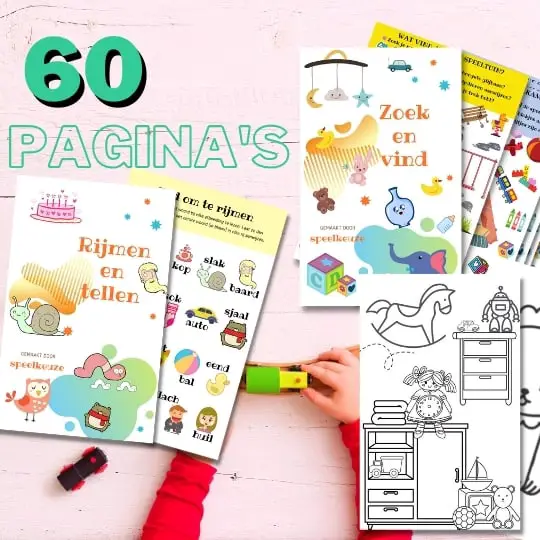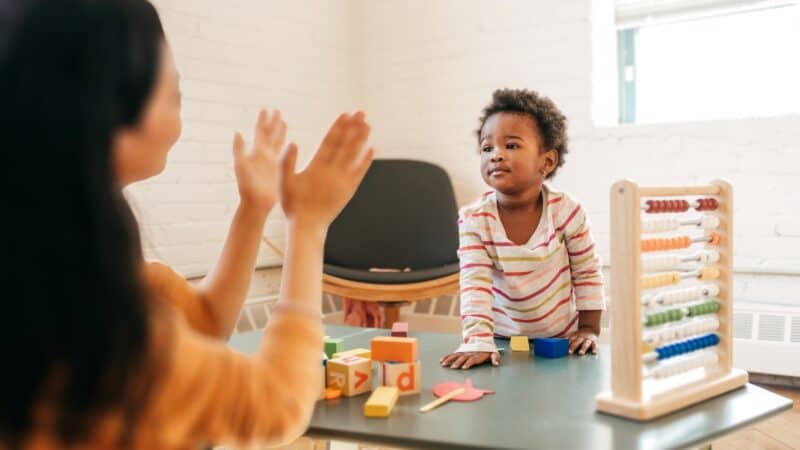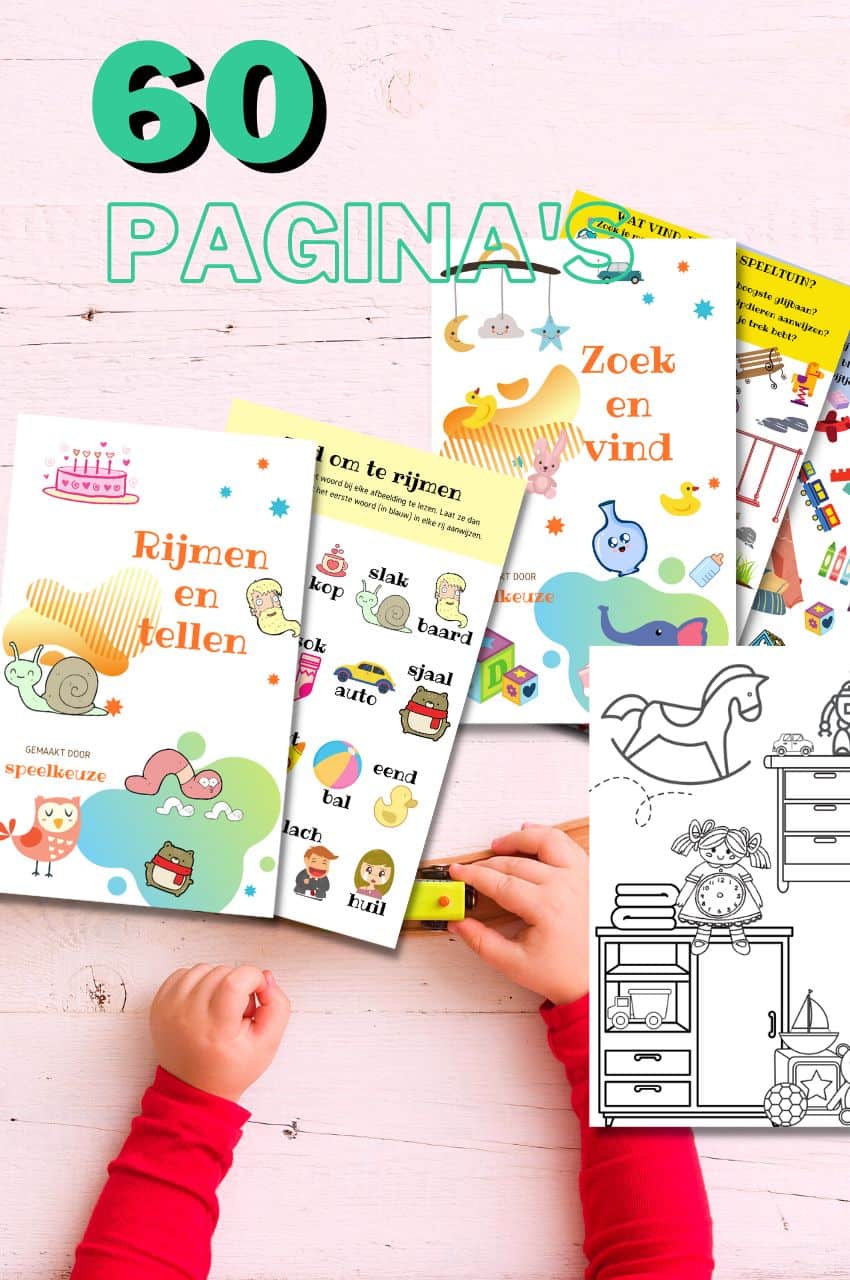Toddler: 11 tips to help them learn through fun play

Always something to do for the holidays or rainy day?
Play Choice now has the ultimate activity book collection, with over 60 pages of fun coloring pages and educational puzzles.
A toddler is a child between 1 and 4 years old. In the Netherlands we also have toddlers, but in many other countries such as America this falls under toddler. During this period, children develop rapidly and this is a continuous process.
Try these tips the next time you play with your toddler and see how even the simplest interactions encourage them to learn and explore the world around them.
Play time is special. Not only is it fun, it is also critical to children's development.
Playing is their 'job' and their way of learning about the world around them.

Through play, babies and toddlers try out new skills, explore their imaginations and creativity and teach them about relationships with other people.
Any activity can be playful for young children, be it driving trucks back and forth or sorting socks.
For example, my son thinks sorting and putting things in containers is one of the nicest things there is.
And each type of game can provide multiple opportunities to learn and practice new skills.
As a parent, you are your child's first and favorite playmate.
From the very beginning of your child's life, he plays with you, whether he is now
- looking at your face while feeding it
- or listen to your voice as you sing to him during his diaper change.
He is working, learning and researching.

From toddler to toddler activity book collection
Educational games and coloring pages for 3 to 6 years
Your toddler and preschooler will love this e-book, along with the accompanying printables. He or she can play with it at every stage of development, together with mom and dad.
Buy at Bol.comWhat we discuss in this comprehensive post:
- 1 Games to do with your toddler
- 2 This way you can play with your toddler
- 2.1 Play constructively with your toddler
- 2.2 See life through your toddler's eyes
- 2.3 Give your toddler your full attention
- 2.4 Adjust your language
- 2.5 Follow your child's lead
- 2.6 Go slow
- 2.7 Read your child's cues
- 2.8 Look at your play area
- 2.9 Play it again, Dad
- 2.10 Adapt play activities to your child's needs
- 2.11 Play with others
- 3 What are undesirable play situations with toddlers?
Games to do with your toddler
Boost your child's development and learning by making playtime meaningful with different species spell.
As a parent, it is important to understand the simplicity of early childhood play and facilitate the enjoyment of play.
There are all kinds of games that are valuable for early childhood learning, including:
Constructive play
This is when your child uses their imagination and skill to make something
- a game with dolls
- or building with blocks as a game, for example.
Constructive play develops problem-solving skills, imagination, fine motor skills and self-esteem.
A fun game with blocks is to see who can build the highest tower, although my kid now especially likes to knock my tower over.
Social game
This includes playing with other kids, whether it's an occasional game in the park with another child they just met or a pre-arranged playdate between peers.
It teaches social skills, such as empathy, and broadens your child's world.
Toddlers find it challenging to play with others until they are about two years old, so don't expect them to share and always play well!
See how far your child is and let them try it out for themselves, some children still play for a long time “next to” others instead of with, but that is also a lot of fun and good for them.
Sensory play
This type of play is very common in babies and toddlers and usually involves stimulating the senses with
- tactile,
- movement,
- sound
- and visual experiences.
For example, a fun game is to put toys or other things in a box with a hole in it and let your child feel it. Then they can see what the thing looks like and make the link.
Practice game
Practice game involves repeating new skills so they can be learned.
Business like
- throw
- or stairs,
- to turn,
- hopping
Physical mastery of skills used in sports or games.
Toddlers and preschoolers learn through play and they love nothing more than mom or dad getting up to their level and playing with them.
Just show it off and they will practice with you.
How do you practice ball games with your toddler?
Playing with balls is great for toddlers. It helps with physical development, teaches cause and effect and improves coordination, fine motor skills and hand-eye coordination. Start with simple activities, such as rolling or throwing a soft ball. Gradually you can increase the difficulty by increasing the distance or throwing the ball higher. This is how you can ball games for your toddler make it a little more difficult each time.
This way you can play with your toddler
So what can you do to get the most out of your child's playtime?
Play constructively with your toddler
- Let your toddler choose the activity or toy.
- Let your toddler start independently and let the game lead most of the time.
- Don't worry about cluttering or cleaning up, just let it go.
See life through your toddler's eyes
- Play on the floor at your toddler's level where you can make eye contact.
- Take the time to take turns playing and talking.
- Make sure your toddler plays and has your focus so you share the playing experience and not just play side by side.
- Accept their manner as also a valid manner.
Give your toddler your full attention
Ai, I still find this tricky man sometimes. To be honest, I always want to secretly check my phone to read a nice dad blog or the latest apps from friends.
But of course they are right.
- Show that you are listening and paying attention to what they are doing by watching and repeating their actions.
- Comment on what your toddler is doing without asking questions or correcting.
- Encourage your toddler as often as possible.
Adjust your language
I'm not one to talk to my son in a high-pitched voice and baby talk, but a little adjustment is really good.
- Use short, simple words to encourage development and understanding.
- Don't argue with what they tell you, repeat what they say to show that you are listening.
- Be very positive, affirmative and enthusiastic in your responses.
Follow your child's lead
Provide an object toys or activity for your baby or toddler and see what he does with it.
It's okay if it's not the "right" way ... maybe let him show you a "new way" too.
Go slow
It's great to show your child how toys works, but try to postpone 'doing it for him' every time.
You can start something like stack one block on top of another and then encourage him to give it a try.
Providing just enough help to keep frustration at bay motivates your child to learn new skills.
Read your child's cues
Your little one may not be able to tell you with words when he's had enough or when he's frustrated, but he has plenty of other ways like
- its sounds
- facial expressions
- and using gestures.
By reading the cues that precede a tantrum, you know when to jump in or go to a new activity.
Reading his cues can also tell you what activities your child prefers.
Look at your play area
- Is the area child-friendly and child-safe?
- Is there too much noise or other distractions?
- Is the area safe to explore?
- Is this a good place for the activity you have chosen now, such as running, throwing balls, or painting?
Checking out your space in advance can help you avoid a tantrum, an accident, or a broken lamp.
Play it again, Dad
While this desire to do things over and over isn't necessarily exciting for moms and dads, it is for their young children.
They practice to be able to take on a challenge.
And when they can do it all by themselves, they are rewarded with a strong sense of their own competence: a confidence that they can be smart and successful creatures.
The more they practice and master new skills, the more likely they are to take on new challenges and continue learning.
So if you're tempted to hide that toy you think you can't play with yourself again, remember the essential role that repetition plays in your child's development.
Adapt play activities to your child's needs
You can be a parent, relative, or caregiver of a child with special needs.
A physical, mental or social disability can occasionally be a challenge to play, and they can be minor things too.
Yet all children learn through play and each play activity can be tailored to a child's unique needs.
The guidelines below can help you think about how to make playtime fun and appropriate for your particular child's skills, preferences and abilities:
- Consider the environment: How do variables such as sound or light affect your child? What is the background noise like in your play area? Is there a television or radio on? Are there many other kids around? If your child seems upset while playing and you've tried everything else, move to a quieter, less stimulating place to play.
- How does your child react to new things: Some babies and toddlers, especially if they have a special need, are easily overstimulated, while others engage in many activities (simultaneously). Try to start playtime slowly, with one toy or object, gradually adding others. See what reactions you get. Does a smile smile when a teddy bear is touched and hugged? Does your child seem startled by the loud noises coming from the toy fire truck?
- How does your child react to different textures, smells and tastes: For example, some objects can be very pleasant for your little one to touch and hold. Others may find them 'funny'. Read your child's cues and adjust the play experience accordingly.
Play with others
It is important for a child to build relationships with peers.
Arrange playdates or look for opportunities for your child to play with other children, such as in the park or during a library reading session, or take him to daycare.
Having fun with peers is an important way in which children learn social skills such as sharing, conflict resolution and empathy and will also help prepare for school.
What are undesirable play situations with toddlers?
There are a number of situations in which a toddler's play may be undesirable. It may still be a normal form of learning, but may be inappropriate at times.
Below you will find the most common types of unwanted play situations for toddlers.
- Toddler plays in bed
- Toddler plays with food
- Toddler doesn't play with toys
- Toddler doesn't play alone
- Toddler prefers to play alone
- Toddler plays with feces
- Toddler pretends to be a baby
1. Toddler plays in bed
Bed play for toddlers, while sometimes unwanted, is usually a normal stage of development around the ages of eighteen months to two years. Consider putting your child to bed a little earlier in the evening to avoid sleep deprivation. Usually it disappears playing in toddlers bed naturally within a week or two, while your child has the opportunity to play safely.
2. Toddler plays with food
Toddlers tend to make quite a mess while eating, such as spitting, throwing, crushing, and even playing with food. It is important to understand that this is normal behavior and that it playing with food for toddlers is a way to learn. Toddlers are experiential learners, and they explore the world through touch and play, including with food.
3. Toddler doesn't play with toys
Sometimes toddlers have difficulty playing with their toys, which may mean they need guidance to understand how to play with certain toys. It's important to remember that when toddlers aren't playing with their toys, they often need to be taught how to play, just as they need to learn other skills.
4. Toddler doesn't play alone
Some toddlers cry and complain when left to play alone, which is normal behavior. Research suggests that problems with independent play often have more to do with the parents than the children, meaning parents can improve the situation by taking the right approach.
5. Toddler wants to play alone, not with others
The opposite situation can also occur, when a toddler wants to play alone, not with other friends. But it is no problem when toddlers play alone, especially if they are under four years old. This process, known as parallel play, is important for their social development. Toddlers who prefer to play alone are usually concerned with their own development and growth.
6. Toddler plays with feces
Toddlers sometimes play with their feces as they explore their environment and body. It is important to respond with understanding and patience. Two of the tips to limit playing with feces are wearing rompers and keeping close supervision.
7. Toddler pretends to be a baby
Toddlers pretending to be babies or animals, such as meowing or saying goo-goo-ga-ga, often do this as part of understanding that other people have thoughts and feelings that are different from their own. It is normal behavior, but if you want to set limits on this imaginative play, it is important to understand your child's intention as they may use this behavior to avoid something, get attention, get something they want, or to communicate.

Always something to do for the holidays or rainy day?
Play Choice now has the ultimate activity book collection, with over 60 pages of fun coloring pages and educational puzzles.
Joost Nusselder, the founder of Speelkeuze.nl is a content marketer, father and loves trying out new toys. As a child he came into contact with everything related to games when his mother started the Tinnen Soldaat in Ede. Now he and his team create helpful blog articles to help loyal readers with fun play ideas.